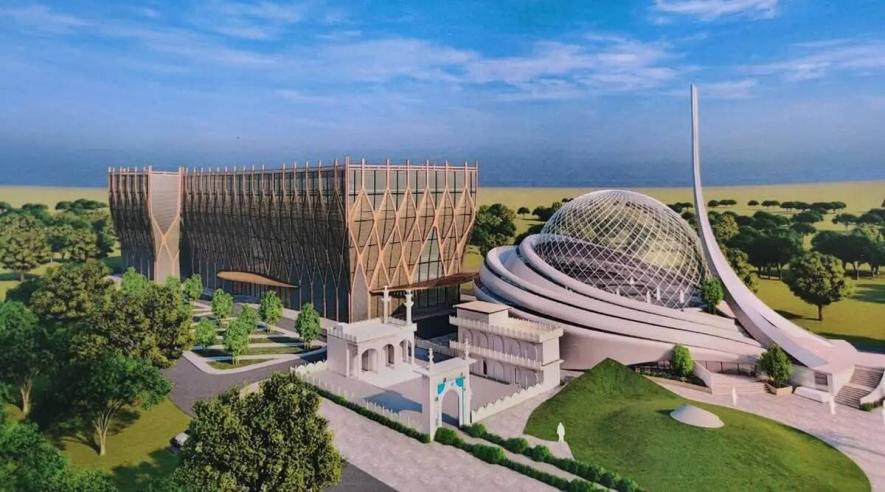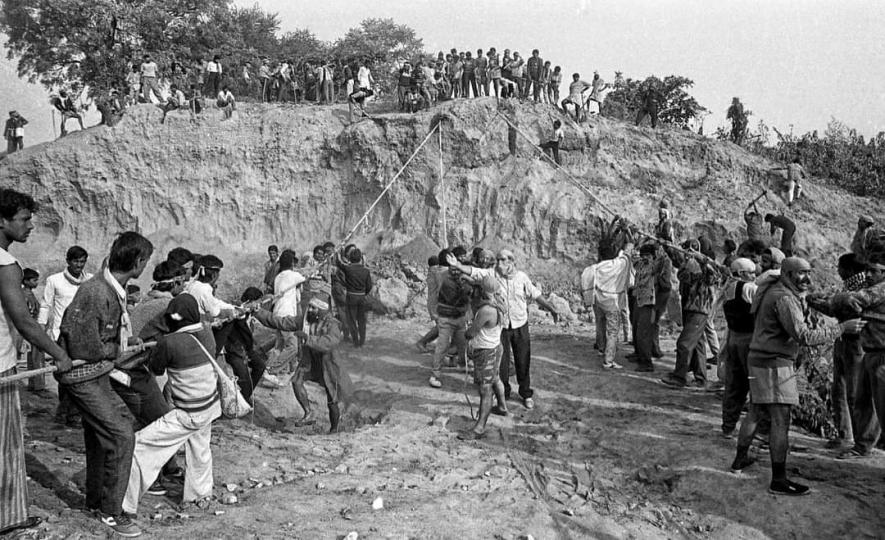Ayodhya Mosque Project in Limbo, Ram Temple Construction in Full Swing

The proposed Masjid-e-Ayodhya, which will come up in Dhannipur village in Ayodhya, Uttar Pradesh. Picture credit: Indo Islamic Cultural Foundation Trust.
New Delhi: Nearly three years after the Supreme Court (SC) ordered the Uttar Pradesh (UP) government to allot 5 acres for the construction of a mosque in Ayodhya and cleared the way for the construction of a Ram Temple at the disputed site, the project is in limbo due to the lack of approval for building maps and no-objection certificates (NOCs) from civic authorities, UP Pollution Control Board and fire services.
On the other hand, with Prime Minister Narendra Modi laying the foundation stone on August 5, 2020, after the SC ordered that the disputed land be handed over to a Trust for building a Ram temple, construction at the site is in full swing.
Following the long-fought Babri Masjid-Ram Janmabhoomi title suit, the apex court in its 1,045-page judgment had ordered the state government in November 2019 to allot 5 acres to the UP Sunni Central Waqf Board for the construction of the proposed mosque Masjid-e-Ayodhya.
The alternate piece of land, located at Dhannipur village, is 24 km away from the disputed 2.77 acres, where the historic Babri Masjid once stood before being demolished on December 6, 1992.
Apart from a mosque that can accommodate 2,000 people at a time, a 300-bed superspeciality hospital, a research centre dedicated to freedom fighter Maulvi Ahmadullah Shah (1857 anti-British war hero) and a community kitchen that will feed about 1,000 people daily were proposed to come up at the alternative land under the supervision of Indo Islamic Cultural Foundation (IICF)—a trust set up by the Waqf Board.
Allegedly keeping it pending for more than a year, the Ayodhya Development Authority (ADA) has expedited clearance to the project only after a joint delegation of the Board and the Trust met ADA vice-chairman Vishal Singh on June 30.
“The IICF (also known as the Ayodhya Masjid Trust) had submitted the drawings of the maps in 11 sets to the ADA on May 25 last year along with Rs 5 lakh as the processing fees for approval.
“We received an official communication only after we met Vishal Singh on June 30 this year. We were asked to apply online on the ADA website for approval. We complied but it needed several NOCs. We reverted to the ADA urging it to secure all the NOCs,” IICF trustee Arshad Afzaal Khan told Newsclick.
“At this juncture, Ayodhya district magistrate Nitish Kumar intervened and deputed an additional district magistrate for the same. On October 18, ADA secretary Satyendra Singh informed us that the plot is agricultural land, according to revenue records. Therefore, no construction can be done on it without changing its use. We were provided with a proforma for an application seeking a change in the land’s use. We did it as well,” Khan further said adding that the application is “still pending with the authorities”.
Nearly two months ago, Khan said, the fire services department refused to ‘issue us an NOC for the mosque and other facilities by objecting to the narrow approach road being less than 12 metres. The Trust has urged the government to resolve the issue as it possesses the vacant land on both sides of the approach road. “We have also not been provided the additional land for widening of the approach road so far,” Khan alleged.
Asked if he sees a contrast between the promptness of authorities in facilitating the construction of two equally religious sites, Khan said it is a “pertinent” question but the government should answer that.
When queried about the same, Singh denied any discrimination and clarified that “technical issues” are being resolved to approve the project.
“The land use of the allotted site has to be changed and an application in this regard is being processed. There are other technical glitches which are also being worked upon. Soon, everything will be resolved,” he said.
Asked about declining the NOC to the project by his department, Ayodhya’s chief fire officer RK Rai said, “The approach road should be 12 metres wide; however, the main approach road is not more than four metres wide. The width of other approach roads is not more than six metres. Therefore, clearance has been withheld and the Trust has been informed about it.”
NO RESEMBLANCE TO BABRI MASJID
According to Khan, who is also in charge of designing, the mosque will not bear any resemblance to the Babri Masjid—built by Mughal emperor Babur’s General Mir Baqi in 1528–29 and a replica of the mosques in the Delhi Sultanate.

Picture credit: Praveen Jain
“Babur is not our ideal. Our ideals are our Sufi saints, freedom fighters and scholars. Therefore, the proposed Masjid-e-Ayodhya will not in any way look like the Babri Masjid. Therefore, the new mosque wouldn’t have any reference to the Mughal-era mosque and its demolition,” he said.
Khan said that the museum on the premises of the proposed mosque will have a memorial dedicated to freedom fighters like Shah. “As per the Islamic teachings of Khidmat-e-Khalq (philanthropy), the proposed complex will have a community kitchen and a hospital to feed the poor and serve the humanity at large,” he added.
Get the latest reports & analysis with people's perspective on Protests, movements & deep analytical videos, discussions of the current affairs in your Telegram app. Subscribe to NewsClick's Telegram channel & get Real-Time updates on stories, as they get published on our website.
























